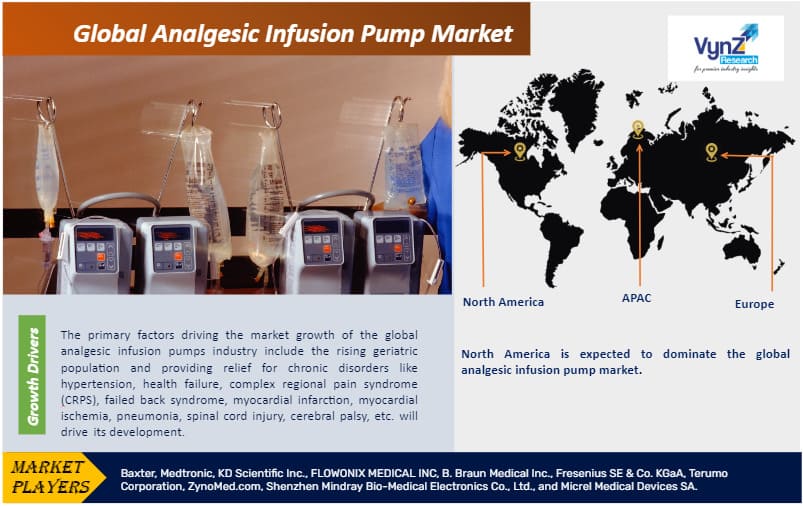| Status : Published | Published On : Dec, 2023 | Report Code : VRHC1275 | Industry : Healthcare | Available Format :

|
Page : 190 |

Global Analgesic Infusion Pump Market – Analysis and Forecast (2025-2030)
Industry Insight by Product Type (Patient-Controlled Analgesia Pump (PCA Pump), Electronic Ambulatory Pumps, and Disposable Infusion Pumps), by Application (Post-Operative Pain Management, Cancer Pain Management, Labor Pain Management, and Chronic Pain Management), by End User (Home Care Settings, Hospitals, and Ambulatory Surgical Centers), and Geography (U.S., Canada, Germany, U.K., France, China, Japan, India, and Rest of the World)
Industry Overview
The Global Analgesic Infusion Pumps Market is expected to grow at a significant pace from USD Billion in 2.8 billion in 2023 to USD 5.23 Billion in 2030. It is predicted to grow at a CAGR of 6.1% during the forecast period. Analgesic infusion pumps are devices that infuse analgesic medications like lidocaine, phenol, morphine, etc. directly into the patient's body to relieve pain. These pumps are increasingly deployed to treat neurological disorders that may result in spasticity of muscles. Analgesic infusion pumps are also called patient-controlled analgesia (PCA) as the device is designed to provide patients with a prescribed quantity of medications when needed. These infusion pumps can be used as external devices or implanted inside the patient's body.

Analgesic Infusion Pump Market Segmentation
Insight by Product Type
Based on Product Type, The Global Analgesic Infusion Pumps Market is segmented into Patient-Controlled Analgesia Pump (PCA Pumps), Electronic Ambulatory Pumps, and Disposable Infusion Pumps. PCA pump is expected to dominate the market as individuals generally use PCA pumps to self-administer prescribed medications at predetermined dosage and time intervals. The use of PCA pumps enhances self-sufficiency, decreases anxiety, and facilitates rapid recovery. PCA pumps are generally utilized in healthcare settings like hospitals by shortening the patient's stay and thus reducing medical expenses. Furthermore, PCA pumps are highly adopted by medical professionals owing to their simplicity and convenience.
Insight by Application
Based on Application, The Global Analgesic Infusion Pumps Market is segregated into Post-Operative Pain Management, Cancer Pain Management, Labor Pain Management, and Chronic Pain Management. Cancer pain management is expected to have the highest growth owing to the rising number of cancer patients worldwide and accessibility of analgesic medication (both opioids and non-opioids) will accelerate market development of the global analgesic infusion pump industry.
Insight by End User
Based on End-User, The Global Analgesic Infusion Pumps Market is categorized into Home Care Settings, Hospitals, and Ambulatory Surgical Centers. Hospitals dominate the market as it is used by hospitals for treatment, diagnosis, and surgical interventions for crucial medical conditions and pain.
Analgesic infusion pumps are increasingly deployed in-home care for pain management therapies like acupuncture, physiotherapy, medication therapy, and sleep management to assist in the speedy recovery of individuals from injury, illness, and postoperative pain, thereby registering a high CAGR during the forecast period. These devices have improved the quality of life for patients suffering from chronic pain by giving continuous analgesia 24 hours a day, seven days a week. The infusion pump delivers an exact dose of medication into the body until it is no longer needed or until further treatment with stronger medication is required.
Global Analgesic Infusion Pump Market Report Coverage
|
Report Metric |
Details |
|
Historical Period |
2018 - 2023 |
|
Base Year Considered |
2024 |
|
Forecast Period |
2025 - 2030 |
|
Market Size in 2024 |
U.S.D. 2.8 Billion |
|
Revenue Forecast in 2030 |
U.S.D. 5.23 Billion |
|
Growth Rate |
6.1% |
|
Segments Covered in the Report |
By Product Type, By Application and By End User |
|
Report Scope |
Market Trends, Drivers, and Restraints; Revenue Estimation and Forecast; Segmentation Analysis; Impact of COVID-19; Companies’ Strategic Developments; Market Share Analysis of Key Players; Company Profiling |
|
Regions Covered in the Report |
North America, Europe, Asia-Pacific, Middle East, and Rest of the World |
Industry Dynamics
Analgesic Infusion Pump Market Growth Drivers
The primary factors driving the market growth of the global analgesic infusion pumps industry include the rising geriatric population and providing relief for chronic disorders like hypertension, health failure, complex regional pain syndrome (CRPS), failed back syndrome, myocardial infarction, myocardial ischemia, pneumonia, spinal cord injury, cerebral palsy, etc. will drive its development. Moreover, reduced cost, rising market demand for minimally invasive pain management techniques, increased investment in healthcare infrastructure to enhance patient care, and the need for effective post-operative pain management will contribute to market advancement. Furthermore, the augmented awareness of analgesic infusion pumps which includes minimizing variability in local anesthetics in maternal and fetal blood and a safe method that uses time efficiently will further propel the market expansion of the global analgesic infusion pump industry.
Analgesic Infusion Pump Market Challenges
The high initial investment required for these devices in consort with maintenance and operational expenses may stymie market expansion in emerging countries. The strict regulatory framework, risk of complication, device malfunction, and dose administration among the geriatric population may further restrain market growth for the global analgesic infusion pump industry.
Analgesic Infusion Pump Market Opportunities
The rising awareness of developed pain management techniques in emerging economies and collaboration with hospitals, healthcare providers, and clinics will lead to increase market deployment of the global analgesic infusion pump industry. Furthermore, rising technological development in infusion pump systems that includes enhanced battery life, integration of smart features, and improved preciseness, thereby providing better control and monitoring to medical professionals will accelerate market opportunities in the global analgesic infusion pump industry.
Analgesic Infusion Pump Market Geographic Overview
-
North America
-
Europe
-
Asia Pacific (APAC)
-
Rest of the World (RoW)
North America is expected to dominate the global analgesic infusion pump market owing to the availability of reimbursement policies, established healthcare infrastructure, rising implementation of technologically developed treatment devices, increased prominence of chronic pain situations, and rising disposable income among people.
Europe is expected to grow significantly during the forecast period owing to the rising number of chronic diseases, implementation of innovative technology, presence of key pump manufacturers, and rising government initiatives and regulations to use innovative medical equipment will bolster the market revenue for the analgesic infusion pump industry.
Analgesic Infusion Pump Market Competitive Insight
The global analgesic infusion pumps industry is highly fragmented, and the key players are adopting strategic partnerships, M&A, and collaborations to enhance their product portfolio. In addition, the industry players are increasingly investing in R&D activities to enhance their product portfolio and upgrade their existing products.
Fluid and gas distribution in the laboratory can be automated and cost-effectively done with the help of KD Scientific's liquid handling equipment. Their goods are known globally for their high quality and dependability at a reasonable price. The company provides low-cost infusion pumps, OEM syringe pumps, syringe pumps, and syringe pumps having infuse and withdraw functions. KD Scientific syringe pumps are perfect for providing exact and precise volumes of fluids for a variety of syringe pump applications such as calibrating a mass spectrometer or reaction chamber, administering long-term medicinal infusions to animals, and general infusion applications. The KDS 100 series syringe pumps are also economical fluid infusion solutions. The LegatoTM series has advanced technologies such as USB an RS232 (RS-232available in Legato 200 Series Only) and TTL interfaces.
Fresenius Kabi provides an extensive range of generic intravenous drugs. Among these medications are analgesics and anesthetics, as well as antibiotics and anti-infectives. Their infusion pumps have a global reputation for being dependable, user-friendly, and always improving to meet clinical needs. The Agilia Connect Infusion System is designed to work with a variety of infusion pump models.
The same interface enables practitioners to switch between pump technologies safely and confidently. All pump types are supported by a unified software suite.
Recent Development by Key Players
B. Braun Medical Inc., one of the pioneer in smart infusion therapy, announced the launch of their next generation of infusion management software, DoseTrac® Enterprise Infusion Management Software. This new platform offers organizations real-time views as well as retrospective reporting tools to help them comprehend their infusion pump fleet and associated data.
Mindray launched its BeneFusion i Series and u Series infusion systems, providing high precision, adaptive customization, and exceptional simplicity for guaranteed levels of pharmaceutical safety in several clinical settings.
Key Players Covered in the Report
Some of the major players operating in the global analgesic infusion pump market include Baxter, Medtronic, KD Scientific Inc., FLOWONIX MEDICAL INC, B. Braun Medical Inc., Fresenius SE & Co. KGaA, Terumo Corporation, ZynoMed.com, Shenzhen Mindray Bio-Medical Electronics Co., Ltd., and Micrel Medical Devices SA.
The Analgesic Infusion Pump Market report offers a comprehensive market segmentation analysis along with an estimation for the forecast period 2025–2030.
Segments Covered in the Report
- Product Type
- Patient-Controlled Analgesia Pump (PCA Pump)
- Electronic Ambulatory Pumps
- Disposable Infusion Pumps
- Application
- Post-Operative Pain Management
- Cancer Pain Management
- Labor Pain Management
- Chronic Pain Management
- End User
- Home Care Settings
- Hospitals
- Ambulatory Surgical Centers
Geographical Segmentation
-
North America
-
U.S.
-
Canada
-
Mexico
-
Europe
-
Germany
-
U.K.
-
France
-
Italy
-
Spain
-
Russia
-
Rest of Europe
-
Asia-Pacific (APAC)
-
China
-
Japan
-
India
-
Rest of the World
-
Brazil
-
Saudi Arabia
-
South Africa
-
U.A.E
-
Other Countries
.png)
Source: VynZ Research
Frequently Asked Questions
Purchase Options
Latest Report
Research Methodology
- Desk Research / Pilot Interviews
- Build Market Size Model
- Research and Analysis
- Final Deliverabvle
Connect With Our Sales Team
- Toll-Free: 1 888 253 3960
- Phone: +91 9960 288 381
- Email: enquiry@vynzresearch.com
Analgesic Infusion Pump Market
